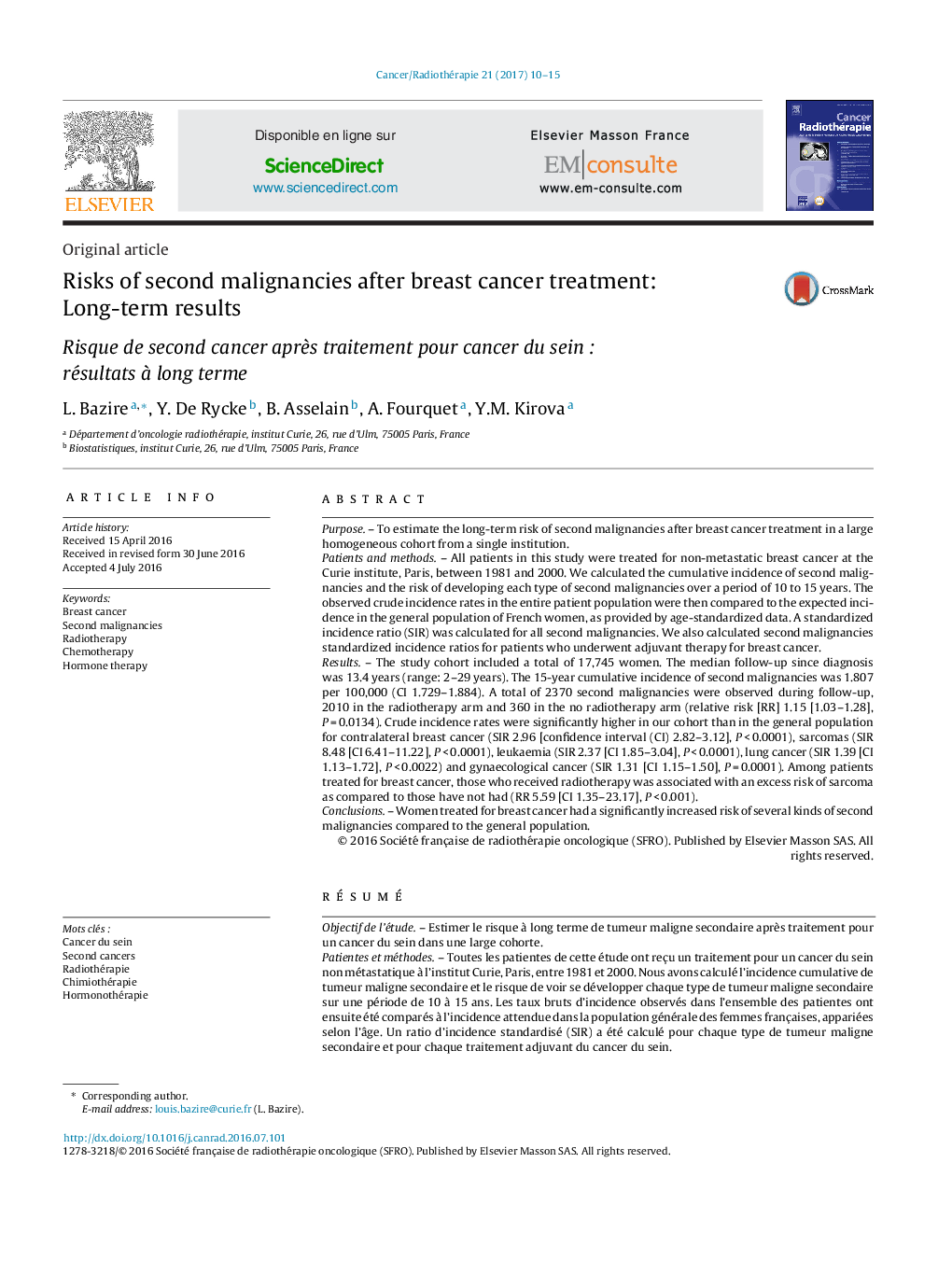| کد مقاله | کد نشریه | سال انتشار | مقاله انگلیسی | نسخه تمام متن |
|---|---|---|---|---|
| 5525938 | 1401507 | 2017 | 6 صفحه PDF | دانلود رایگان |

PurposeTo estimate the long-term risk of second malignancies after breast cancer treatment in a large homogeneous cohort from a single institution.Patients and methodsAll patients in this study were treated for non-metastatic breast cancer at the Curie institute, Paris, between 1981 and 2000. We calculated the cumulative incidence of second malignancies and the risk of developing each type of second malignancies over a period of 10 to 15Â years. The observed crude incidence rates in the entire patient population were then compared to the expected incidence in the general population of French women, as provided by age-standardized data. A standardized incidence ratio (SIR) was calculated for all second malignancies. We also calculated second malignancies standardized incidence ratios for patients who underwent adjuvant therapy for breast cancer.ResultsThe study cohort included a total of 17,745Â women. The median follow-up since diagnosis was 13.4Â years (range: 2-29Â years). The 15-year cumulative incidence of second malignancies was 1.807 per 100,000 (CI 1.729-1.884). A total of 2370Â second malignancies were observed during follow-up, 2010 in the radiotherapy arm and 360 in the no radiotherapy arm (relative risk [RR] 1.15 [1.03-1.28], PÂ =Â 0.0134). Crude incidence rates were significantly higher in our cohort than in the general population for contralateral breast cancer (SIR 2.96 [confidence interval (CI) 2.82-3.12], PÂ <Â 0.0001), sarcomas (SIR 8.48 [CI 6.41-11.22], PÂ <Â 0.0001), leukaemia (SIR 2.37 [CI 1.85-3.04], PÂ <Â 0.0001), lung cancer (SIR 1.39 [CI 1.13-1.72], PÂ <Â 0.0022) and gynaecological cancer (SIR 1.31 [CI 1.15-1.50], PÂ =Â 0.0001). Among patients treated for breast cancer, those who received radiotherapy was associated with an excess risk of sarcoma as compared to those have not had (RR 5.59 [CI 1.35-23.17], PÂ <Â 0.001).ConclusionsWomen treated for breast cancer had a significantly increased risk of several kinds of second malignancies compared to the general population.
RésuméObjectif de l'étudeEstimer le risque à long terme de tumeur maligne secondaire après traitement pour un cancer du sein dans une large cohorte.Patientes et méthodesToutes les patientes de cette étude ont reçu un traitement pour un cancer du sein non métastatique à l'institut Curie, Paris, entre 1981 et 2000. Nous avons calculé l'incidence cumulative de tumeur maligne secondaire et le risque de voir se développer chaque type de tumeur maligne secondaire sur une période de 10 à 15 ans. Les taux bruts d'incidence observés dans l'ensemble des patientes ont ensuite été comparés à l'incidence attendue dans la population générale des femmes françaises, appariées selon l'âge. Un ratio d'incidence standardisé (SIR) a été calculé pour chaque type de tumeur maligne secondaire et pour chaque traitement adjuvant du cancer du sein.RésultatsLa cohorte de l'étude comprenait au total 17 745 femmes. Le suivi médian depuis le diagnostic était de 13,4 ans (2-29 ans). L'incidence cumulée de tumeur maligne secondaire à 15 ans était 1,807 pour 100 000 (intervalle de confiance [IC] = 1,729-1,884). Un total de 2370 de tumeurs malignes secondaires ont été observées au cours du suivi, 2010 dans le bras radiothérapie et 360 dans le bras sans radiothérapie (relative risk [RR] = 1,15 (1,03-1,28), p = 0,0134). Les taux d'incidence bruts étaient significativement plus élevés dans notre cohorte que dans la population générale pour le cancer du sein controlatéral (SIR 2,96 [IC 2,82-3,12], p < 0,0001), les sarcomes (SIR 8,48 [IC 6,41-11,22], p < 0,0001), la leucémie (SIR 2,37 [IC 1,85-3,04], p < 0,0001), le cancer du poumon (SIR 1,39 [IC 1,13-1,72], p < 0,0022) et les cancers gynécologiques (SIR 1,31 [IC 1,15-1,50], p = 0,0001). Parmi les patientes traitées pour un cancer du sein, celles qui ont reçu de la radiothérapie ont été plus souvent atteintes de sarcome (RR 5,59 [IC 1,35-23,17], p < 0,001).ConclusionsLes femmes recevant un traitement pour un cancer du sein ont un risque significativement accru de plusieurs types de tumeur maligne secondaire par rapport à la population générale.
Journal: Cancer/Radiothérapie - Volume 21, Issue 1, February 2017, Pages 10-15